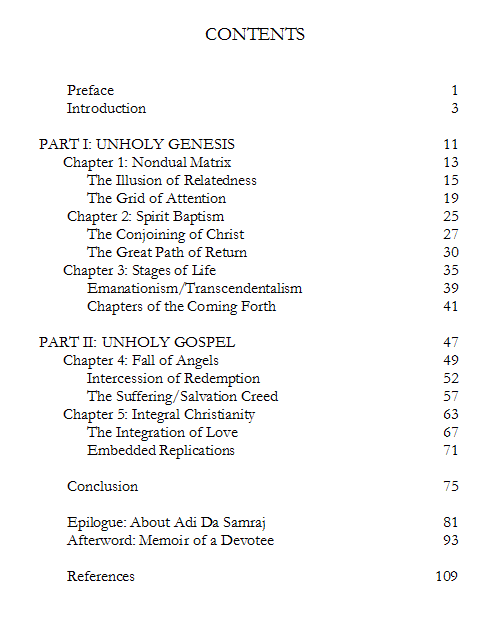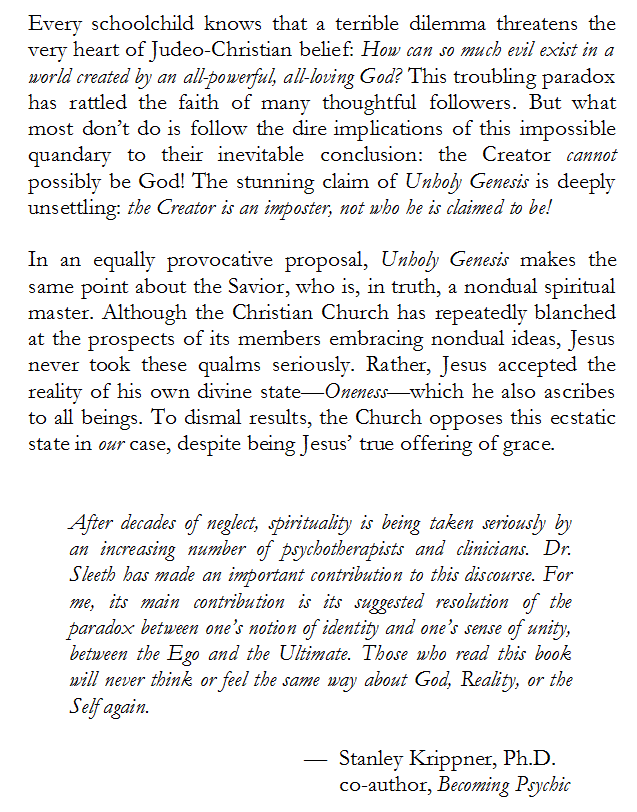


Stanley Krippner (born October 4, 1932) is an American psychologist, parapsychologist, and an executive faculty member and Professor of Psychology at Saybrook University in Oakland, California. Formerly, Krippner was director of the Kent State University Child Study Center (of Kent, Ohio), and director of the Maimonides Medical Center Dream Research Laboratory (of Brooklyn, New York).
PREFACE
What makes this book so unusual is that I’m a Christian…who doesn’t believe in Christianity. Actually, that’s not entirely true. I’m a Christian who believes in Christ but has real qualms about Christianity, which misrepresents Christ. It’s up to us to honor his legacy and set the record straight. Or so it seems to me. If something about Christianity doesn’t add up but you can’t quite put your finger on it, this is the book for you.
Yet, things didn’t start out that way. At first, like my friends, I believed what I was told, especially if it came from my parents. By what would I compare? It wasn’t until later I learned adulthood involves an improbable task: taking stock of beliefs and reevaluating them, based on knowledge and experience gleaned from life—especially the view of others not just like you. It turns out my parents grew up without questioning what they were led to believe. Here’s some good advice. Don’t be like my parents!
My moment of truth with Christianity came early, amusingly, around third grade. I was in Sunday school, diligently receiving instruction on the happy news that Jesus loves me, which seemed reasonable enough. But the crucifixion and salvation were not nearly so soothing, much less inspiring as exemplars of that love. What moved me had far greater potential: the mystery of resurrection. That was plenty for me. It was Jesus’ life that seemed to hold out promise of something hopeful, not his demise. Honestly, I still can’t imagine what was going on inside the ancient mind, that it could take comfort in human sacrifice. It certainly didn’t mean much to me.
On that eventful Sunday school morning, I went up to the Bible studies teacher and shared the wonder of a momentous discovery. I confided that I could duplicate Jesus’ resurrection, secretly hoping for her approval. She appeared to find my enthusiasm endearing, for the moment accepting the pretentiousness of such a claim. In fact, she challenged me good-naturedly to demonstrate. I had brought a copy of the Bible, in which the ribbon of the page-marker was placed at a full-color pastel picture of Jesus, gazing serenely out amongst the blurry pages of text. I had her look at the picture, and then closed the book, declaring solemnly that the crucifixion had been done. Waiting monumentally for just a hint of impatience, I revealed the miracle. Opening the book again, the exact same picture of Jesus appeared! I happily announced his resurrection.
Astonishing, she was not amused. Vigorously hushing me, her stiff nails gripped me at the shoulder while a threatening finger wagged my way. She made it clear I had committed blasphemy, playing with the sacred ordeal of our Lord and Savior. Apparently, I had no appreciation for the enormity of Jesus’ sacrifice made on my behalf. In the glare of her outrage, I was quickly flustered. Attempting to fathom my offense, I had to think fast, made all the worse by an alarming discovery: she was right! I really didn’t appreciate the sacrifice of our Lord and Savior. In fact, it made no sense at all and never had. Even at that tender age, it seemed an utter waste of spiritual succor had surely taken place. With this act, clearly, humanity had committed an egregious affront against God. And worse, far as I could tell, felt compelled to complicate matters by setting up Sunday school classes like this one, where teachers announced with solemn giddiness that all was OK—for Jesus still loves us, secretly behind the deal the whole time.
It never occurred to me anyone could be kicked out of Sunday school. But I was a troubled child in those days, so really wasn’t all that surprising, looking back on it. As a young boy, I tried to sort things out, make sense of why people held onto ideas that are clearly incomprehensible. Startling, I could see that adults didn’t have the answers, which put me squarely on the spot. I was all on my own. They seemed more concerned with consolation than anything else. I could have easily joined the crowd then but opted for honesty instead, which struck me as a better guiding light. Indeed, it has been my life-long goal to discern truth, starting I suppose from that day.
If this incident wasn’t bad enough, I was having a hard time accepting black or white thinking, which doesn’t tolerate any shades in between. This faulty judgment is the way children see things, not to say adults languishing in that same insular reasoning. Christianity accepts a particularly appalling duality in this regard—heaven and hell—which leads to nearly the exact opposite outcome intended. Consider the confession of one Church pastor dissatisfied with his faith, which appears in an amazingly intimate book, If God is Love, by Phillip Gulley and James Mulholland:
After I became certain of my salvation, I applied the same harsh standards to others. Hell and damnation allowed me to judge and condemn those different from me. They were wicked, and I was good. The chosen are free to do great evil to those they consider damned. My teachers and preachers praised my spiritual sensitivity, when actually I was scared to death. I want to change that world by envisioning a world shaped by God’s redemptive love for all.
Dogma is a volatile elixir indeed! Perhaps you have your own story. If it’s not completely clear, the impropriety comes down to a harrowing deficit: hell only makes sense to those lacking empathy. Honestly, whose heart is so black they could take comfort in the torment of others? For all eternity?? Is God really capable of that!? These are human ideas, coming from ancient times, putting words in God’s mouth for our sake. Hell serves no purpose, except for those trying to save their own skin, perhaps even requiring others to be damned and take their place instead of going themselves. The same is true of the cross—what some call “fire insurance”—a deterrent to hell, so long as you are not on the wrong side of its pointed message.
Even so, neither is really the problem. Rather, it is a violent, exclusive, and intolerant image of God intended toward revenge that undermines peace and happiness in the world—no matter who the religious perpetrator, peddling their nefarious holy wars. It is time to admit that this all has to stop. Any love that would send a multitude of people to eternal damnation is questionable, if not obsolete, certainly not anything intended by Jesus.
Despite admiration deserved by Christianity, some of its doctrine has fallen into disrepute. To illustrate, a spirited debate has sprung up over any further use of the cross. At the very least its eerie tribute is selfish, intended solely for our benefit. The purpose of the cross is life everafter, preferably in heaven; too bad at God’s expense. You have to hand it to these inspired entrepreneurs. If nothing else, they made the most of a bad situation.
In a recent series of articles appearing in the contemplative Jewish magazine, Tikkun, Lawrence Swaim portrays the difficulty this way:
At the heart of Christianity [is] a disturbing doctrine, both Protestant and Catholic, [that] maintains God allowed Jesus to be tortured to death in public in order to redeem human beings, so that God might reconcile himself to his own creation. This patriarchal doctrine makes God out a vengeful, homicidal deity who can be satisfied only with the death of his son. This vision of God is so reprehensible, and sufficiently different from the God of love as taught by Jesus, that it poses an unsolvable and irreducible moral problem.
Some might find calling the cross evil a bit much, being too hard on the poor Christians. Yet, human sacrifice is precisely the issue. It is no doubt understandable how the cross was found laudable during ancient times, given our historical lust for blood and gory spectacle; from wild animals tearing apart human flesh in the coliseums of the Roman Empire, to brutal executions put on display through the Middle Ages for public amusement, to even childhood exhortations rising up over the schoolyard, calling out, “Fight! Fight!” A morbid fascination has always accompanied our interest in making sure someoneelse receives the blows—in our place. Regrettably, Jesus wasn’t the first, and certainly not the last.
The inclination to cling to ancient ways remains prevalent even today. In his rebuttal examining these difficult issues, C. Kavin Rowe appears alarmed, taking exception to any criticism of the cross:
Ignorance of major world religions comes in many forms today, but Lawrence Swaim’s particular version is still stunning. Of the many historically and argumentatively strange things in his essay, his call for Christians to get rid of the symbol of the cross is the most bizarre. Getting rid of the cross is tantamount to getting rid of Jesus—which is to say, of Christianity.
Something strange is going on alright. Consider the situation from the standpoint ofJesus. He never existed during a time in which the cross was associated with him! His entire ministry took place without the slightest reference to the cross. How odd to think getting rid of the cross would in any way affect his presence in Christianity. Did he really have no life before death? How could such confusion possibly happen? However strange to say, Christianity is being hijacked by the cross and held for ransom—for no better reason, apparently, than to comfort our jitters.
The Bible is notoriously intriguing in this respect. In fact, this little expose unravels the Gospels like any good murder mystery—lots of clues and plot twists, even occasional red herring thrown in. However, this work is not a “who done it” so much as a “why do it”? The motive for the murder smacks of an alibi that won’t hold up. For best results, consider other leads. One cannot settle for what was said but must read between the lines to find what has been left out, what these scriptures really mean. This takes a little interpretation. Therefore, this work is relevant not only to all Christians but Jews, or anyone else wondering what all the fuss is about. No doubt, there are many who suspect something is surely amiss.
Like any good prophecy, the purpose of this essay is simple enough: rebuke questionable tenets. More, the idea is to clarify two topics of great interest to people around the world—Christ and Creator—showing thereby how their relationship to God remains poorly understood. Yet, a far more coherent picture of God, Christ, and Creator is possible. Although the prospects for accomplishing such a task might seem precarious, this work shows it can be done. It just requires a willingness to think outside the box. In doing so, an unprecedented blessing is offered to the Christian religion.
Continue Reading….

PDF Format

“Those are the eyes of an Enlightened man!”

This is the picture that appeared on the poster, art from the cover of the first book published by Adi Da in 1972, The Knee of Listening, his spiritual autobiography. (The Knee of Listening has since been revised and newer editions are also available.)

Contact Daniel – Daniel_Sleeth(AT)adidam.org